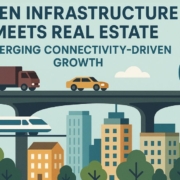When Infrastructure Meets Real Estate: Emerging Connectivity-Driven Growth
As cities expand and develop, property itself is undergoing a similar transformation, with connectivity being the beacon of change. The old saying “location, location, location” now means much more than just a good pin code. It means access, mobility, and connectivity to a broader urban system. This convergence of infrastructure and real estate is reshaping the way people buy homes and invest in real estate.
The Infrastructure Boom: A Catalyst for Real Estate Growth
New roads, metro routes, highways, and smart city developments have created a ripple effect in the real estate market. Areas that were once far-flung or underdeveloped are now bustling with activity. As commuting times shrink and accessibility to facilities improves, demand for real estate rises.
The moment the announcement of an infrastructure project is made be it a flyover, ring road, metro extension, or an IT corridor it generates immediate interest among the colonies in the vicinity. Buyers and investors start looking for alternatives in the region, and property prices go up, along with projects getting launched. The demand for apartments on sale goes up exponentially in such high-potential zones.
Connectivity: The New Definition of Livability
For today’s homebuyers, especially nuclear families and city dwellers, time is money. They seek housing that saves them daily commutes to offices, schools, or health centers. This feature makes connectivity an important factor in home choice.
Well-linked suburbs offer accessibility, enhanced quality of life, and long-term appreciation. For instance, areas with quick highway or metro access will have higher rates of apartment absorption of properties on offer than areas with poor transport links. Real estate developers are also taking note of this trend by constructing schemes along transport corridors and adding last-mile connectivity solutions.
Infrastructure’s Role in Price Appreciation
The best reason infrastructure spurs real estate is its pure impact on price appreciation. An added subway line or an added highway widening doesn’t just make life easier it also boosts property prices in the long term.
Sophisticated investors closely monitor such trends. Most invest in future corridors well before high-value infrastructure completion, selling at a profit when the projects materialize. It’s a tactic, where a short-term investment in a strategically positioned apartment today becomes a treasure for high returns tomorrow.
Suburban Growth: Mapping the Real Estate Terrain
Suburbs that were previously ignored are witnessing a property boom, thanks to improved infrastructure. While cities are becoming crowded, the suburbs are becoming popular as desirable substitutes with roomy houses, cleaner air, and relatively low-priced options.
This is especially witnessed in the demand for apartments in Porur newly reached suburbs. They now boast of good roads, direct public transport accessibility, and social amenities like schools, shopping malls, and hospitals. The outcome is a blended lifestyle where city convenience is combined with suburban tranquility.
Integrated Townships and Transit-Oriented Development (TOD)
Another emerging trend is Transit-Oriented Development, which involves residential areas, business, and commercial strips built around transport hubs. The districts are designed to utilize public transportation, reduce traffic levels, and provide a walkable environment.
Townships along major expressways or metro stations are offering everything from offices and schools to shopping and entertainment within walking distance. Such projects are highly sought after by clients seeking apartments for sale that offer convenience as well as lifestyle.
Economic Impact: Job Creation and Demand Growth
Development also creates jobs. From the construction team to IT professionals, every department benefits from new areas of development. This economic development also creates increased demand for homes, especially rental and ownership dwellings for additional workers.
It is a cyclical process good infrastructure pulls in citizens, citizens create demand, demand attracts development, and development sparks more infrastructure.
Sustainability and Smart Infrastructure
The modern real estate market is also cutting-edge when it relates to sustainability goals. Solar-powered street lamps, rainwater harvesting systems, and electric vehicle (EV) charging stations are becoming mainstream.
The majority of apartments found in the market today form green communities that are interconnected with smart infrastructure, offering a sustainable way of living. The trend is drawing environment-conscious homebuyers and investors.
Final Thoughts: A Win-Win Equation
The intersection of real estate and infrastructure equals a compelling growth story. It is reshaping where and how people live. With increased connectivity, previously overlooked regions are being revitalized into vibrant communities that are rich with opportunity, convenience, and ease.
For homebuyer purchasers, the clever thing to do is to look outside downtown regions and look for areas that are on the cusp of development. New transit lines and civic enhancements on the horizon mean many neighborhoods are ready for the long term.If you want to purchase flats for sale in Ramapuram, it is the time to look towards infrastructure-driven development. It is not merely about the property it is about the future lifestyle, convenience, and value the place has in store.

